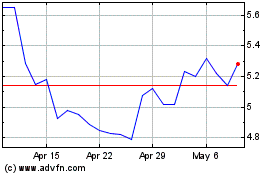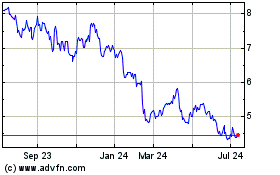By Christopher Alessi
Imagine an elevator that moves without attached cables, and can
travel horizontally or vertically, sharing a shaft with several
other cabs.
That is the vision of German industrial conglomerate
Thyssenkrupp AG, which aims to use magnetic-levitation technology
to revolutionize a business that has essentially delivered the same
product for over a century.
Thyssenkrupp hopes by adapting maglev technology used in
high-speed trains, it could elbow aside rivals including United
Technologies Corp.'s Otis unit, the world's largest and oldest
elevator maker.
Otis and Thyssenkrupp's two other global competitors, Finland's
Kone Corp. and Switzerland's Schindler Group, are taking
incremental approaches to innovation for their people-movers.
Kone offers carbon-fiber elevator cables that have higher
tensile strength than traditional metal, permitting taller shafts.
Otis and Schindler have focused on improving the computers that
manage how banks of elevators operate, seeking to cut passengers'
waiting times and improve efficiency. Thyssenkrupp offers similar
systems.
Only the storied German steel and engineering company is
proposing to eliminate the elevator cable altogether, fashioning a
kind of hyperloop for commercial buildings. Thyssenkrupp already
runs a scaled-down mock-up and later this year aim to demonstrate a
full-size working prototype. If all goes well, sales could begin as
soon as next year.
"It will definitely take some years to filter through, but it's
a start, " said Andreas Schierenbeck, chief executive of
Thyssenkrupp's elevator division. He predicted the technology,
dubbed Multi, would ultimately make elevators faster and more
efficient while transforming the way buildings are constructed.
Rivals are skeptical.
"So far, these kinds of concepts have not been commercially
viable," said Kone Chief Executive Henrik Ehrnrooth.
Silvio Napoli, Schindler's former chief executive and now a
director, said horizontal elevator concepts are "not that new for
the industry."
"Competitors were working on this years ago but found problems,"
including high energy consumption, he said.
Otis in the 1990s designed a system to run both vertically and
sideways, but its intricate system of pulleys and cables proved too
complex to install, according to Dario Trabucco, a researcher at
the Council on Tall Buildings and Urban Habitat, a nonprofit
standards organization.
Otis declined to comment for this article.
James Fortune, an expert at Fortune Shepler Saling Inc., an
elevator consultancy that works with developers and architects,
said Thyssenkrupp's biggest challenges will be "to develop a
working system that would be cost-competitive" and to convince
developers they should take the risk of using its unique and
proprietary system.
Today's high-speed single elevators typically cost between
$400,000 and $600,000 a shaft, he said. A Thyssenkrupp spokesman
said pricing estimates for Multi aren't yet available but "the
savings in reduced footprint for super-tall and mega-tall buildings
is enormous and pays off easily."
Replacing an installed elevator system could cost millions of
dollars, and in some structures could be impossible. So developers
shun risk.
"This will be a very niche market," said Andre Kukhnin, an
equity analyst at Credit Suisse, noting that buildings would need
to be designed entirely around Thyssenkrupp's system. Mr. Kukhnin
said an evolutionary technology like Kone's carbon-fiber rope may
have a bigger impact on the industry.
Kone's Mr. Ehrnrooth said its synthetic belts, which are already
in use, are much lighter than traditional steel cables, so its
system consumes less energy and costs less to maintain. Kone says
its "UltraRope" will allow elevators to double today's maximum
shaft height of about 500 meters.
Longer shafts reduce the need for elevator transfer lobbies on
high floors, boosting rentable space, experts say.
Still, Thyssenkrupp's Multi is the first big break from cables
in 160 years. Rather than operating like a yo-yo, it hovers each
cab vertically or horizontally with magnetic fields.
Floating up a tower might make some elevator riders skittish but
the average passenger is "absolutely ignorant" about how elevators
work, said Mr. Trabucco at the Council on Tall Buildings. Enticing
riders shouldn't be hard if the system is fast, he said.
Thyssenkrupp said it is still developing safety features in
coordination with consultants and building developers. It said all
Multi elevators will employ a "multistep braking system" to handle
"all possible scenarios of operation."
Thyssenkrupp started actively developing the technology in the
1970s with German engineering group Siemens AG for a high-speed
train project that was canceled in Germany, though one of their
Transrapid trains runs in Shanghai.
"But the technology is there...the patents are there," said
Thyssenkrupp's Mr. Schierenbeck. Rivals, he noted, "don't have
access to that technology."
Albert So, an elevator expert at the Asian Institute for Built
Environment, predicted magnetic-levitation elevators would
eventually spread because it is the only available technology that
could allow more than two cars in a shaft. Such sharing would
significantly boost efficiency.
Thyssenkrupp since 2003 has offered a more traditional cable
system that runs two independent cabins in one shaft. The system
ensures the cars stay safely separated. It operates in several tall
buildings, including the new European Central Bank headquarters in
Frankfurt.
Write to Christopher Alessi at christopher.alessi@wsj.com
(END) Dow Jones Newswires
July 18, 2016 17:17 ET (21:17 GMT)
Copyright (c) 2016 Dow Jones & Company, Inc.
Thyssenkrupp (PK) (USOTC:TKAMY)
Historical Stock Chart
From Jun 2024 to Jul 2024

Thyssenkrupp (PK) (USOTC:TKAMY)
Historical Stock Chart
From Jul 2023 to Jul 2024
